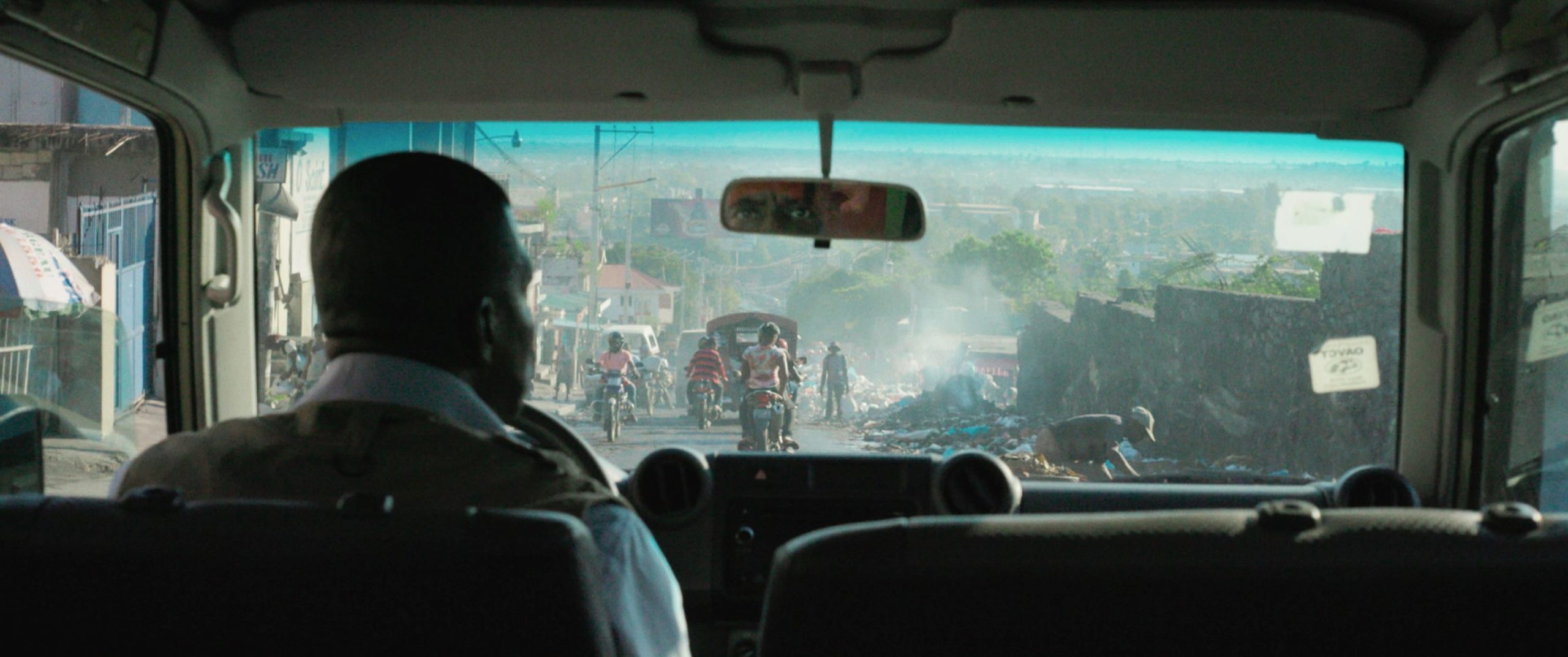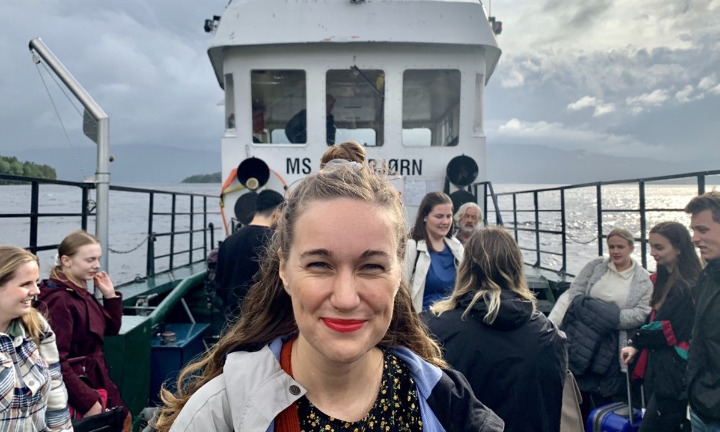In zo reken, Emanuel Licha’s second feature-length documentary, the powerful symbolism of white Toyota Land Cruisers, commonly used by international NGOs and the police, is turned on its head.
“This vehicle means either NGO or repression. It means power in any case,” says a Haitian man about the tough four-wheel drive zo reken (“shark bones”) vehicles that are omnipresent in Haiti’s capital Port-au-Prince.
As the zo reken in Licha’s innovative essay film manoeuvers around the barricades and the chaotic streets of Port-au-Prince, its Haitian passengers speak candidly about the current state of their country and the repercussions of “chronic” humanitarian aid.
The audio component of this film was of prime importance to Licha who has decades of experience creating art installations in which “sound must envelop the audience.” The spare—but compelling—sound of zo reken was developed by veteran sound designer Catherine Van Der Donckt and composer David Drury.
Emanuel Licha is a Montreal-based artist and filmmaker. His oeuvre has been presented as film festivals and contemporary art institutions worldwide.
POV spoke to the director prior to the film’s virtual premiere at Hot Docs 2021.
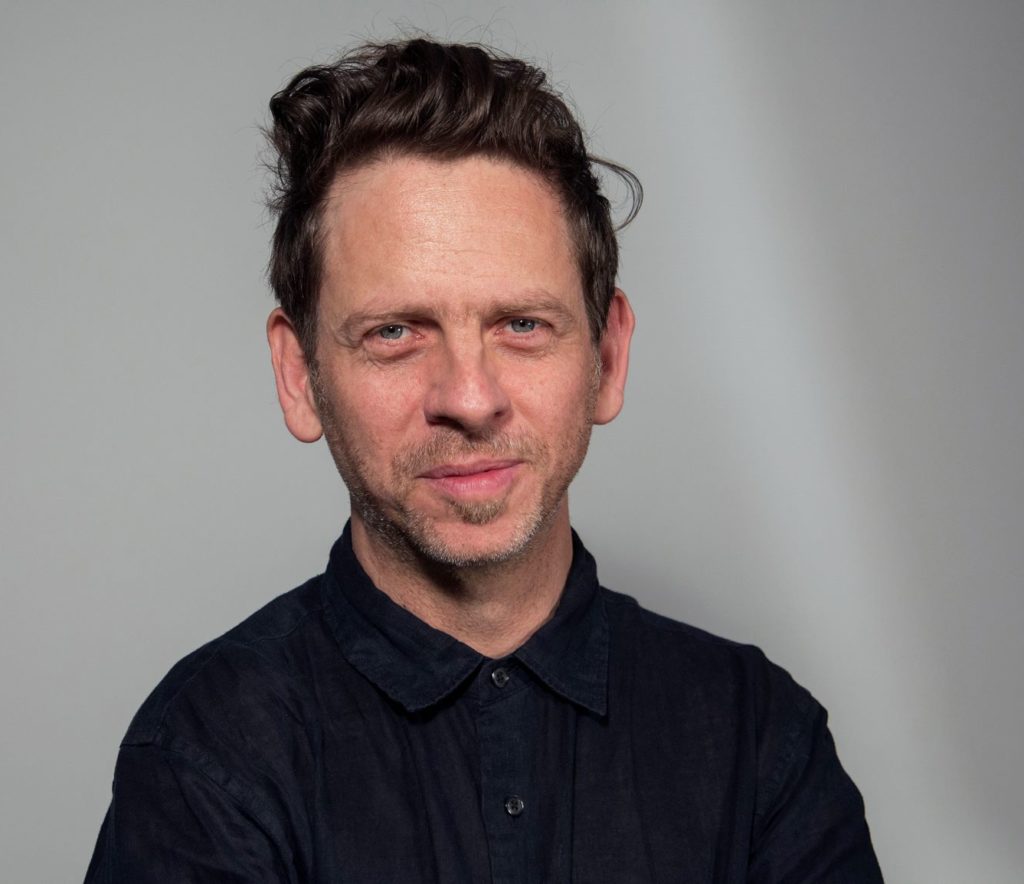
POV: Megan Durnford
EL: Emanuel Licha
POV: When did you first have the idea to employ a zo reken as a mobile “soap box”?
EL: A long time ago, long before I was a filmmaker, I was a Master’s student in urban geography. I was very interested in West Africa so I decided to do my field placement there. At the time, I was very excited about the idea of working in international co-operation. When I arrived in Burkina Faso, my research team welcomed me and gave me a tour of the city in a 4 × 4, a robust all-terrain vehicle. The team leader demonstrated the power of this vehicle (and maybe his power too) by speeding along the packed dirt roads. It was just after the rainy season…and it was very dangerous. We brushed by many pedestrians and cyclists. He found this very funny but I was completely horrified—not just because of his driving—but because I was a young white guy who had just arrived and was immediately placed in this position of power. It was very upsetting. Then again, at that age, our critical abilities are not well honed. Over the next six months, I was placed in several situations like this, as a privileged white person. There was something that did not feel right. At that point, I would not have been able to speak of global economics, neo-colonialism etc. But viscerally, I knew something was not right.
So I made a major career shift—instead of pursuing a career in international development, I decided to study fine arts. This happened about 30 years ago. For quite a while, I have felt that I should address that episode of my life. It really bothered me that I had participated in that type of situation. I didn’t want to address the issue in an accusatory way or by examining the dominance of developed countries over developing countries. So I decided to focus on a spatial object—this is typical of my artistic practice— in this case, the vehicle that is emblematic of power and inequality. This type of vehicle is fascinating for me because it is used for both assistance and power/repression. This type of complex object is always my starting point. A zo reken can be used for both assistance and repression. This complexity is at the heart of what I want to explore.
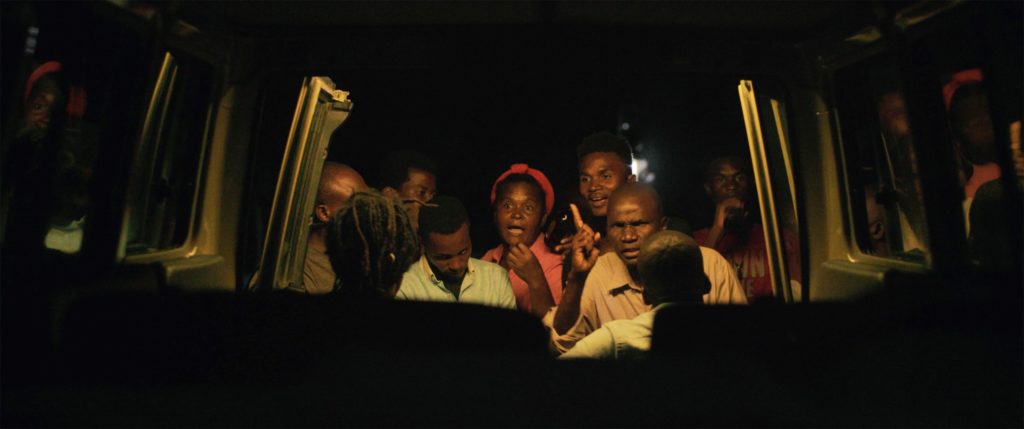
POV: Many subjects speak Haitian Creole. How did you deal with this challenge?
EL: The driver, Pascal Antoine (who is not a driver in real life) played a significant role. A few years ago, I was in Haiti for location scouting, looking for a fixer, and I met Pascal. After spending some time with him, I started to imagine that he could be the “driver”— that he could be my avatar— and speak with the passengers who spend time in the zo reken.
As I introduced my project to each passenger, I explained that I would like them to converse with Pascal in the language of their choice (French or Creole). I realized that I might miss out on some of the conversation. But that was part of the idea. Pascal understood the project and I really trusted him. I was always in the vehicle. Most of the time, I had no trouble understanding the gist of the conversation. Sometimes I passed him a note asking him to reorient the conversation in a specific way.
It was ok that I did not understand every single word. I did not feel the need for simultaneous translation. There are other things going on…such as, a certain energy! On the other hand, before the edit, key footage was translated so that the editor could fully understand the dialogue.
By the way, speaking of the “driver”…I did not want to define him. I did not want people to grasp who he was. Is he the driver of an NGO? (nothing indicates that) Is he a journalist? Is he a fixer? I wanted to blur the lines. Does he work for someone? Where is he going? Why is he always looking for the right way to go? I intentionally did not hire a professional driver. I did not want this role to be limited in scope. I wanted him to have agency, to be able to take decisions, to have his own opinions.
POV: I am interested in the range of passengers who appear in the film. It feels as though some passengers were invited to participate and the appearances of others are spontaneous? Could you talk about the selection of characters?
EL: Yes, that’s how it happened—some were invited and some were spontaneous. During the year before the shoot, I was in close contact with Rodeney Cirius (who is in the film) a professor of sociology at the State University of Haiti who is currently living in Montreal and working on his PhD at the University of Montreal. He helped me to refine my knowledge of Haiti. Rodeney is very involved in the Haitian academic milieu as well as activist circles. So, he helped me to identify potential subjects.
Also, in order to find other people who might be interested in participating, on the first day of filming we attached a large red sign with white lettering to the side of the van announcing our project and inviting interested locals to contact us by phone or e-mail. For every subject, whether they were invited in advance or found via the panel, I asked them, “Where do you want to go? Which part of the city do you want to show us?”
There is a very dramatic scene involving an injured passenger. We had just arrived at the Haitian Community Hospital with a subject who wanted to talk about healthcare when Rodeney told us that Radio Zenith (a radio station that is popular with activists) was looking for someone who could transport a severely injured person from that hospital to another one—to serve as an ambulance. Right from the start of this project, I had wanted to “decolonize” this object (the zo reken), by making it useful to Haitians during the shoot. Perhaps to offer a ride to someone who is tired (even if they have nothing to do with the film). So, it was obvious to me that we would help transport this person, who had been seriously injured during a protest and who had been waiting to see a doctor for three days.
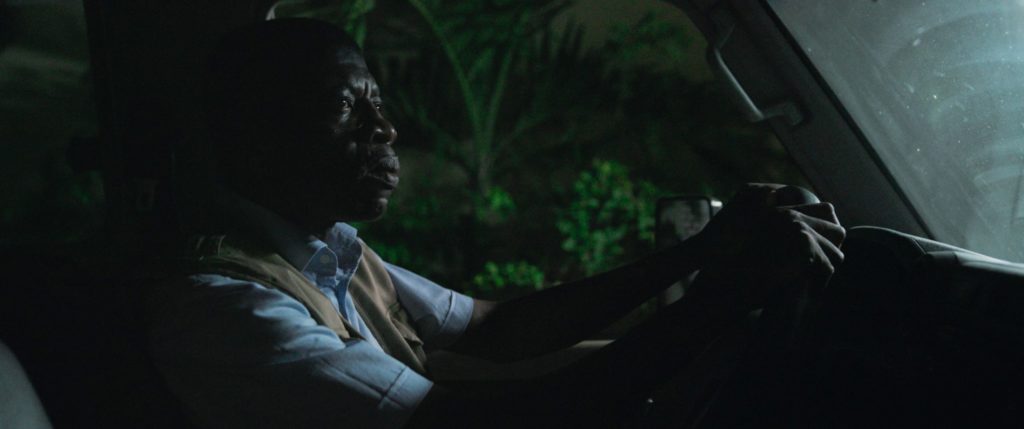
POV: Considering that Médecins sans Frontières (Doctors without Borders) is not portrayed in a very flattering light, I am curious about how you gained access to their warehouse.
EL: I believe that Médecins sans Frontières (MSF) is one of the most rigorous NGOs regarding its role, agency, in the international “traffic” of humanitarian aid. This organization has an ongoing in-depth reflection regarding their role. That’s why I thought of including them in the film. I am not interested in finger-pointing. In fact, during the edit, we made a point of keeping some of the dialogue about the important role that NGOs played after the (2010) earthquake. I know that MSF has disengaged from certain countries because they are aware of the potential for detrimental and counterproductive effects of NGO aid. MSF is actively engaged in debates and discussions regarding these questions. I introduced myself as a researcher who is interested in the complexity and issues associated with humanitarian aid. My approach was frank and honest and I think that MSF understood my line of inquiry.
POV: How has your contemporary art practice informed the creation of zo reken?
EL: I think that becoming an artist allowed me to be the geographer that I couldn’t be. As I already explained, I did not want to be part of a neo-colonial milieu. I found the field of geography, the way that it was practiced, was very limiting. When I was proposing topics for my thesis, I was frequently told “no, that’s anthropology.” I felt stifled. (There may well have been geographers who were more open-minded but unfortunately I had not met them)
Even as an artist, sometimes I feel more like a humanities researcher than an artist. In artist “spaces,” I have found places that welcome the kind of questions that interest me.
POV: zo reken will likely reach a much broader audience than your short creative documentaries and video installations. Was the contemporary art world starting to feel too confining?
EL: Contemporary artworks do not circulate easily. There are many projects that I have worked on for months or years—as much effort as I spent on this film!—that were presented only one time in one gallery. It is very difficult to find venues (and also time slots) for these artworks. Once, I was lucky enough to have a solo exhibit at the MAC (Montreal’s contemporary art museum). That was very special. But it was a project that had been in discussion for four to five years.
My first foray into cinema happened kind of accidentally. About 12 years ago, I was presenting Mirages — a short film about a mock Iraqi village that is used for US military training. Mirages was conceived as an installation, with two projectors on two screens, and it was presented this way in art spaces such as Montreal’s SBC Gallery of Contemporary Art. Mirages was invited to the Rencontres Internationales Paris/Berlin. In my mind, this project was clearly an installation. About a month before it began, I called to ask about how the installation would be set up, and I was told “oh no it’s a screening.” This was very unsettling. I had always felt that a spectator sitting still in a cinema was too passive. I was interested in situations where viewers could move around a screen, be physically involved. So suddenly I had to change my project to a split screen film (which was not satisfying to me). But finally, this split screen film was presented at the Centre Pompidou and it was a success. Subsequently it was invited to numerous film festivals, including Rotterdam and IndieLisboa. During Q & A sessions at these festivals, I discovered that—contrary to what I expected—the viewers were extremely engaged and they asked very thoughtful questions (more thoughtful than the type of questions that I was used to answering during vernissages!) This positive experience made me want to pursue cinema. I really appreciate the broad distribution of films. And I like the way the discussion of a film becomes a starting point for speaking about broader issues. The film is a sort of trigger. Also, a film can have a long life, longer than a video installation (in my experience).
zo reken has its Canadian premiere at Hot Docs 2021.




